Analyzing Social Media Usage in Workplace Communication: MNG81001
VerifiedAdded on 2023/04/21
|8
|1452
|494
Report
AI Summary
This report examines the multifaceted role of social media in professional environments, focusing on its advantages and disadvantages within the context of workplace communication. The study uses Sunrise 100, a company that experienced an information leak on social media, as a case study to illustrate the practical implications of social media usage. The report highlights how social media boosts employee motivation and fosters innovation, especially in companies expanding globally. However, it also addresses potential drawbacks, such as unauthorized access to information and legal complications resulting from data breaches. Furthermore, the report analyzes the impact of employee behavior on an organization's brand image and recommends specific social media interaction policies, including access restrictions and data security measures, to mitigate risks and enhance effective communication. Finally, the report concludes that while social media offers numerous benefits, organizations must implement controls to prevent data leakage and protect sensitive business information.
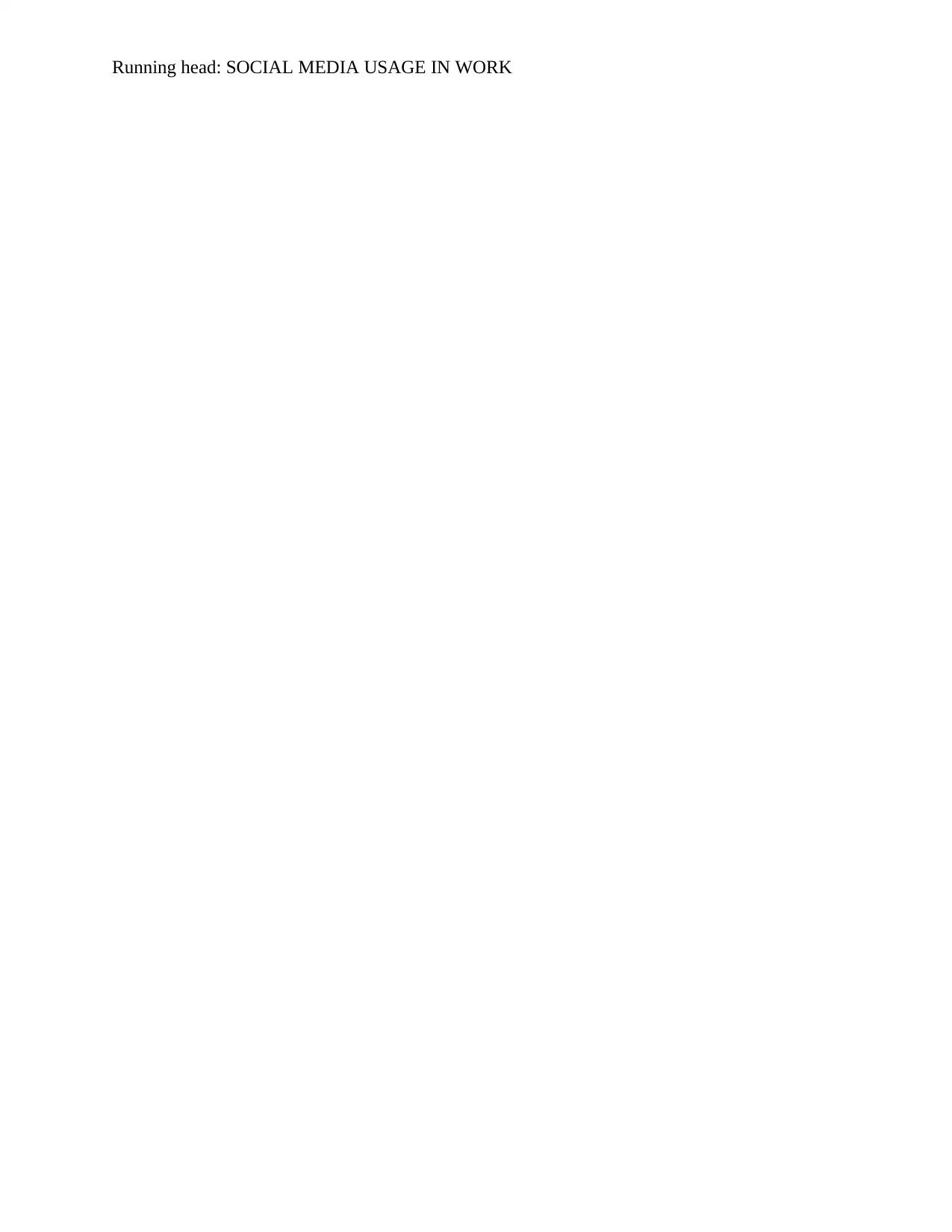
Running head: SOCIAL MEDIA USAGE IN WORK
Paraphrase This Document
Need a fresh take? Get an instant paraphrase of this document with our AI Paraphraser
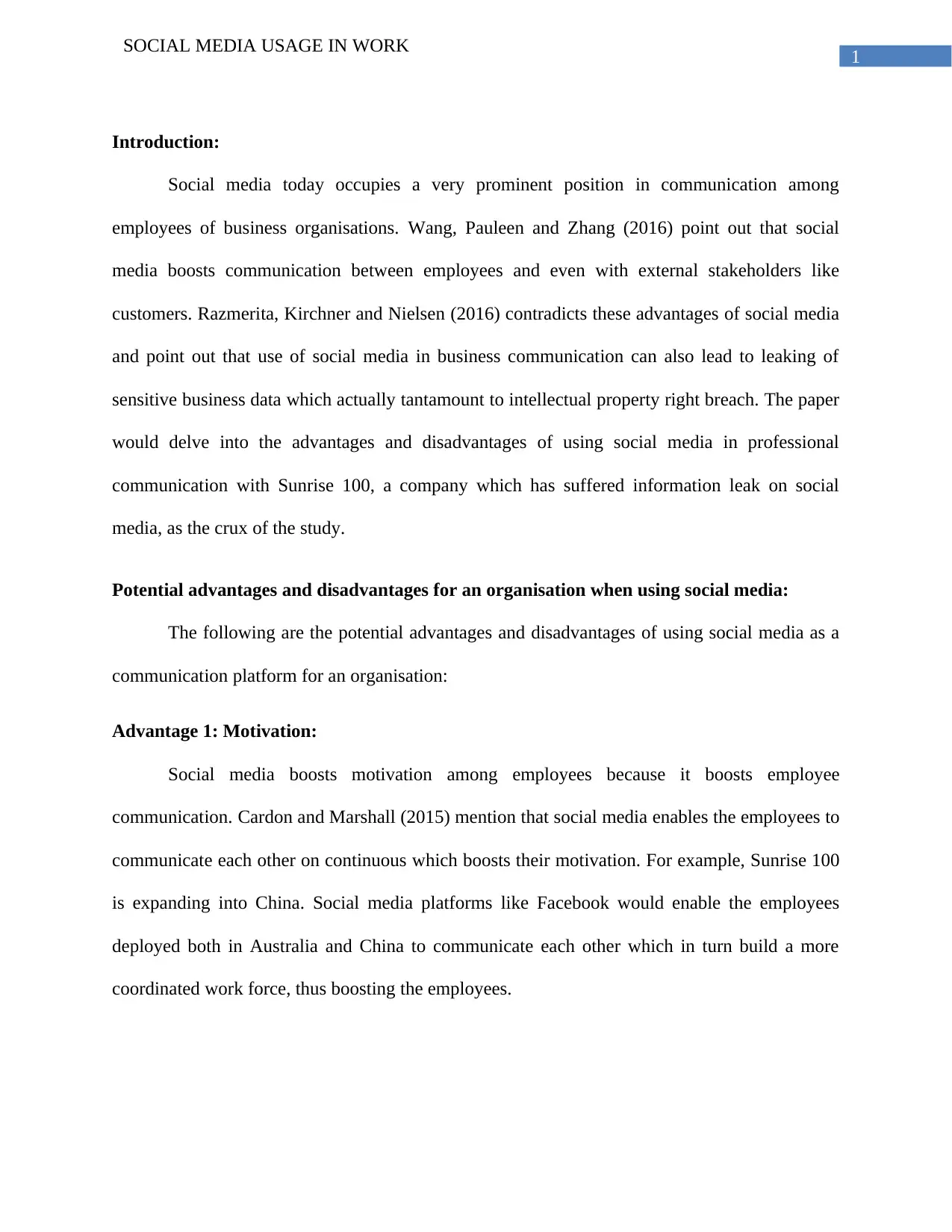
1
SOCIAL MEDIA USAGE IN WORK
Introduction:
Social media today occupies a very prominent position in communication among
employees of business organisations. Wang, Pauleen and Zhang (2016) point out that social
media boosts communication between employees and even with external stakeholders like
customers. Razmerita, Kirchner and Nielsen (2016) contradicts these advantages of social media
and point out that use of social media in business communication can also lead to leaking of
sensitive business data which actually tantamount to intellectual property right breach. The paper
would delve into the advantages and disadvantages of using social media in professional
communication with Sunrise 100, a company which has suffered information leak on social
media, as the crux of the study.
Potential advantages and disadvantages for an organisation when using social media:
The following are the potential advantages and disadvantages of using social media as a
communication platform for an organisation:
Advantage 1: Motivation:
Social media boosts motivation among employees because it boosts employee
communication. Cardon and Marshall (2015) mention that social media enables the employees to
communicate each other on continuous which boosts their motivation. For example, Sunrise 100
is expanding into China. Social media platforms like Facebook would enable the employees
deployed both in Australia and China to communicate each other which in turn build a more
coordinated work force, thus boosting the employees.
SOCIAL MEDIA USAGE IN WORK
Introduction:
Social media today occupies a very prominent position in communication among
employees of business organisations. Wang, Pauleen and Zhang (2016) point out that social
media boosts communication between employees and even with external stakeholders like
customers. Razmerita, Kirchner and Nielsen (2016) contradicts these advantages of social media
and point out that use of social media in business communication can also lead to leaking of
sensitive business data which actually tantamount to intellectual property right breach. The paper
would delve into the advantages and disadvantages of using social media in professional
communication with Sunrise 100, a company which has suffered information leak on social
media, as the crux of the study.
Potential advantages and disadvantages for an organisation when using social media:
The following are the potential advantages and disadvantages of using social media as a
communication platform for an organisation:
Advantage 1: Motivation:
Social media boosts motivation among employees because it boosts employee
communication. Cardon and Marshall (2015) mention that social media enables the employees to
communicate each other on continuous which boosts their motivation. For example, Sunrise 100
is expanding into China. Social media platforms like Facebook would enable the employees
deployed both in Australia and China to communicate each other which in turn build a more
coordinated work force, thus boosting the employees.
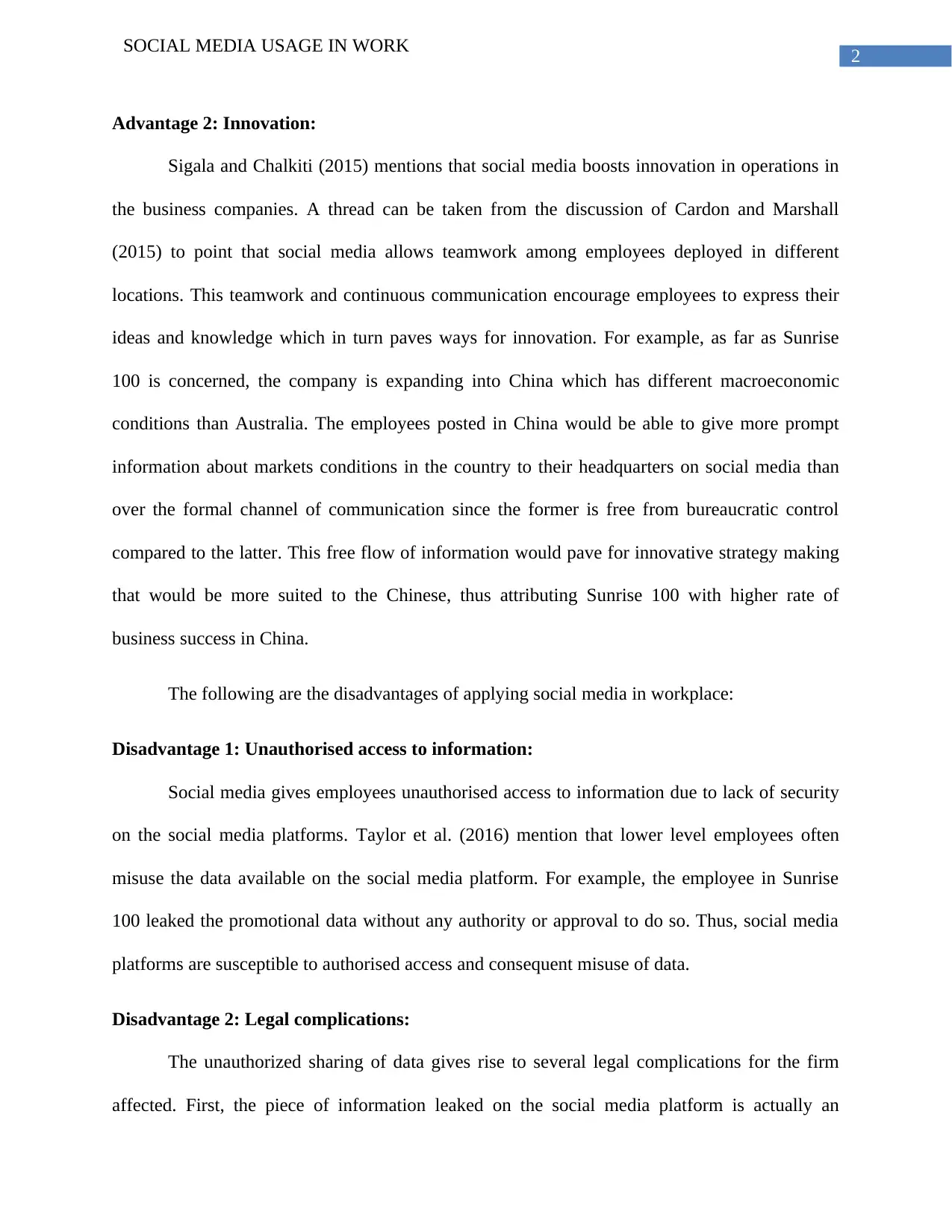
2
SOCIAL MEDIA USAGE IN WORK
Advantage 2: Innovation:
Sigala and Chalkiti (2015) mentions that social media boosts innovation in operations in
the business companies. A thread can be taken from the discussion of Cardon and Marshall
(2015) to point that social media allows teamwork among employees deployed in different
locations. This teamwork and continuous communication encourage employees to express their
ideas and knowledge which in turn paves ways for innovation. For example, as far as Sunrise
100 is concerned, the company is expanding into China which has different macroeconomic
conditions than Australia. The employees posted in China would be able to give more prompt
information about markets conditions in the country to their headquarters on social media than
over the formal channel of communication since the former is free from bureaucratic control
compared to the latter. This free flow of information would pave for innovative strategy making
that would be more suited to the Chinese, thus attributing Sunrise 100 with higher rate of
business success in China.
The following are the disadvantages of applying social media in workplace:
Disadvantage 1: Unauthorised access to information:
Social media gives employees unauthorised access to information due to lack of security
on the social media platforms. Taylor et al. (2016) mention that lower level employees often
misuse the data available on the social media platform. For example, the employee in Sunrise
100 leaked the promotional data without any authority or approval to do so. Thus, social media
platforms are susceptible to authorised access and consequent misuse of data.
Disadvantage 2: Legal complications:
The unauthorized sharing of data gives rise to several legal complications for the firm
affected. First, the piece of information leaked on the social media platform is actually an
SOCIAL MEDIA USAGE IN WORK
Advantage 2: Innovation:
Sigala and Chalkiti (2015) mentions that social media boosts innovation in operations in
the business companies. A thread can be taken from the discussion of Cardon and Marshall
(2015) to point that social media allows teamwork among employees deployed in different
locations. This teamwork and continuous communication encourage employees to express their
ideas and knowledge which in turn paves ways for innovation. For example, as far as Sunrise
100 is concerned, the company is expanding into China which has different macroeconomic
conditions than Australia. The employees posted in China would be able to give more prompt
information about markets conditions in the country to their headquarters on social media than
over the formal channel of communication since the former is free from bureaucratic control
compared to the latter. This free flow of information would pave for innovative strategy making
that would be more suited to the Chinese, thus attributing Sunrise 100 with higher rate of
business success in China.
The following are the disadvantages of applying social media in workplace:
Disadvantage 1: Unauthorised access to information:
Social media gives employees unauthorised access to information due to lack of security
on the social media platforms. Taylor et al. (2016) mention that lower level employees often
misuse the data available on the social media platform. For example, the employee in Sunrise
100 leaked the promotional data without any authority or approval to do so. Thus, social media
platforms are susceptible to authorised access and consequent misuse of data.
Disadvantage 2: Legal complications:
The unauthorized sharing of data gives rise to several legal complications for the firm
affected. First, the piece of information leaked on the social media platform is actually an
⊘ This is a preview!⊘
Do you want full access?
Subscribe today to unlock all pages.

Trusted by 1+ million students worldwide
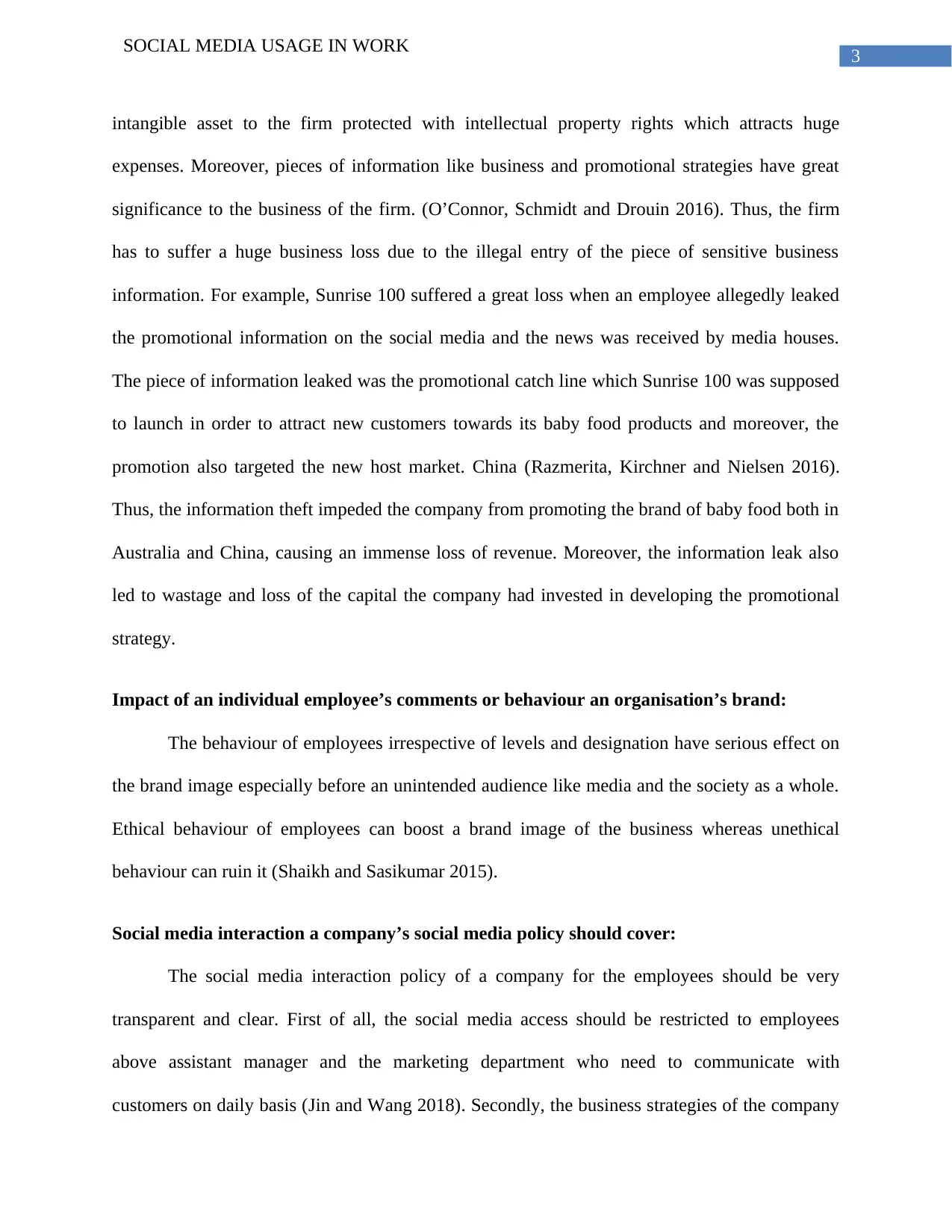
3
SOCIAL MEDIA USAGE IN WORK
intangible asset to the firm protected with intellectual property rights which attracts huge
expenses. Moreover, pieces of information like business and promotional strategies have great
significance to the business of the firm. (O’Connor, Schmidt and Drouin 2016). Thus, the firm
has to suffer a huge business loss due to the illegal entry of the piece of sensitive business
information. For example, Sunrise 100 suffered a great loss when an employee allegedly leaked
the promotional information on the social media and the news was received by media houses.
The piece of information leaked was the promotional catch line which Sunrise 100 was supposed
to launch in order to attract new customers towards its baby food products and moreover, the
promotion also targeted the new host market. China (Razmerita, Kirchner and Nielsen 2016).
Thus, the information theft impeded the company from promoting the brand of baby food both in
Australia and China, causing an immense loss of revenue. Moreover, the information leak also
led to wastage and loss of the capital the company had invested in developing the promotional
strategy.
Impact of an individual employee’s comments or behaviour an organisation’s brand:
The behaviour of employees irrespective of levels and designation have serious effect on
the brand image especially before an unintended audience like media and the society as a whole.
Ethical behaviour of employees can boost a brand image of the business whereas unethical
behaviour can ruin it (Shaikh and Sasikumar 2015).
Social media interaction a company’s social media policy should cover:
The social media interaction policy of a company for the employees should be very
transparent and clear. First of all, the social media access should be restricted to employees
above assistant manager and the marketing department who need to communicate with
customers on daily basis (Jin and Wang 2018). Secondly, the business strategies of the company
SOCIAL MEDIA USAGE IN WORK
intangible asset to the firm protected with intellectual property rights which attracts huge
expenses. Moreover, pieces of information like business and promotional strategies have great
significance to the business of the firm. (O’Connor, Schmidt and Drouin 2016). Thus, the firm
has to suffer a huge business loss due to the illegal entry of the piece of sensitive business
information. For example, Sunrise 100 suffered a great loss when an employee allegedly leaked
the promotional information on the social media and the news was received by media houses.
The piece of information leaked was the promotional catch line which Sunrise 100 was supposed
to launch in order to attract new customers towards its baby food products and moreover, the
promotion also targeted the new host market. China (Razmerita, Kirchner and Nielsen 2016).
Thus, the information theft impeded the company from promoting the brand of baby food both in
Australia and China, causing an immense loss of revenue. Moreover, the information leak also
led to wastage and loss of the capital the company had invested in developing the promotional
strategy.
Impact of an individual employee’s comments or behaviour an organisation’s brand:
The behaviour of employees irrespective of levels and designation have serious effect on
the brand image especially before an unintended audience like media and the society as a whole.
Ethical behaviour of employees can boost a brand image of the business whereas unethical
behaviour can ruin it (Shaikh and Sasikumar 2015).
Social media interaction a company’s social media policy should cover:
The social media interaction policy of a company for the employees should be very
transparent and clear. First of all, the social media access should be restricted to employees
above assistant manager and the marketing department who need to communicate with
customers on daily basis (Jin and Wang 2018). Secondly, the business strategies of the company
Paraphrase This Document
Need a fresh take? Get an instant paraphrase of this document with our AI Paraphraser
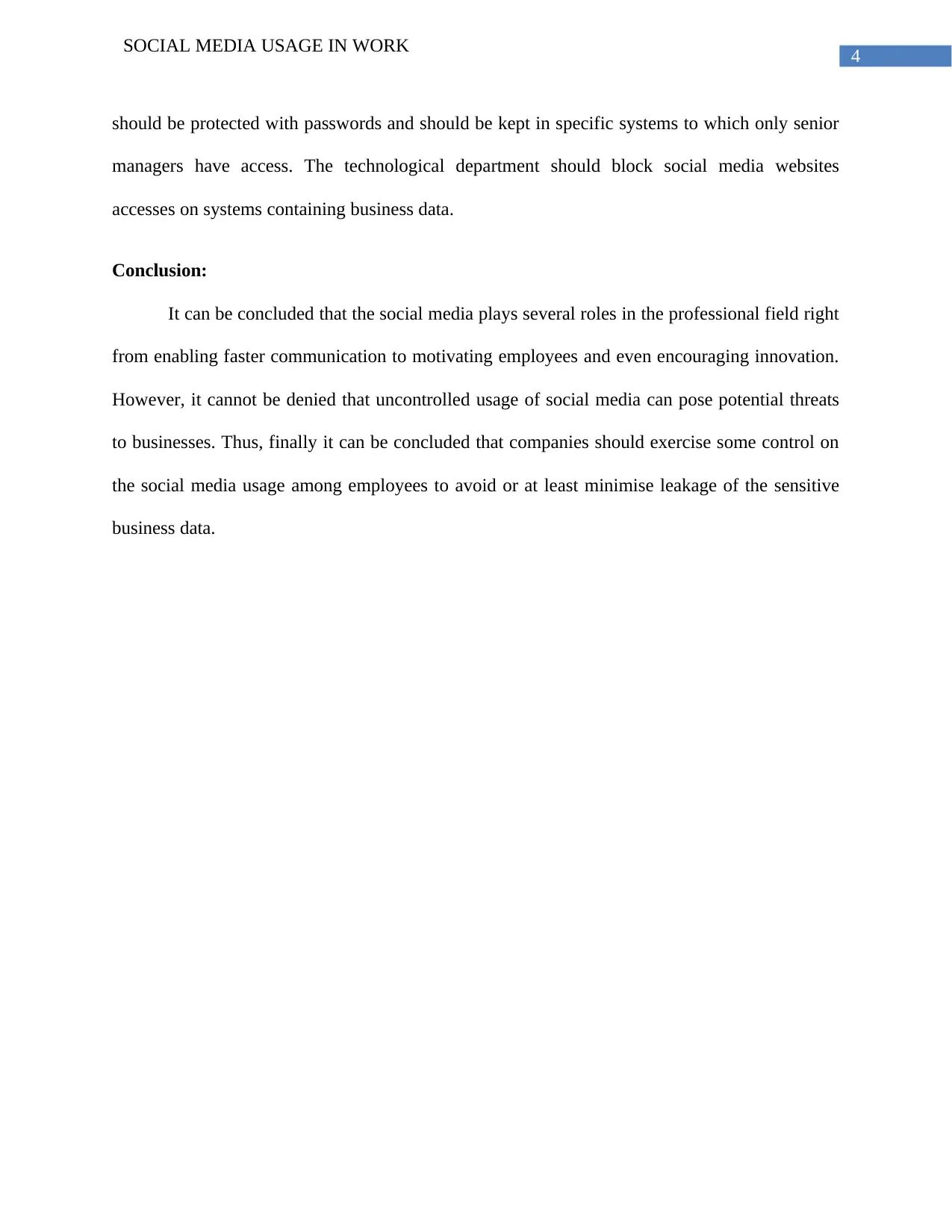
4
SOCIAL MEDIA USAGE IN WORK
should be protected with passwords and should be kept in specific systems to which only senior
managers have access. The technological department should block social media websites
accesses on systems containing business data.
Conclusion:
It can be concluded that the social media plays several roles in the professional field right
from enabling faster communication to motivating employees and even encouraging innovation.
However, it cannot be denied that uncontrolled usage of social media can pose potential threats
to businesses. Thus, finally it can be concluded that companies should exercise some control on
the social media usage among employees to avoid or at least minimise leakage of the sensitive
business data.
SOCIAL MEDIA USAGE IN WORK
should be protected with passwords and should be kept in specific systems to which only senior
managers have access. The technological department should block social media websites
accesses on systems containing business data.
Conclusion:
It can be concluded that the social media plays several roles in the professional field right
from enabling faster communication to motivating employees and even encouraging innovation.
However, it cannot be denied that uncontrolled usage of social media can pose potential threats
to businesses. Thus, finally it can be concluded that companies should exercise some control on
the social media usage among employees to avoid or at least minimise leakage of the sensitive
business data.
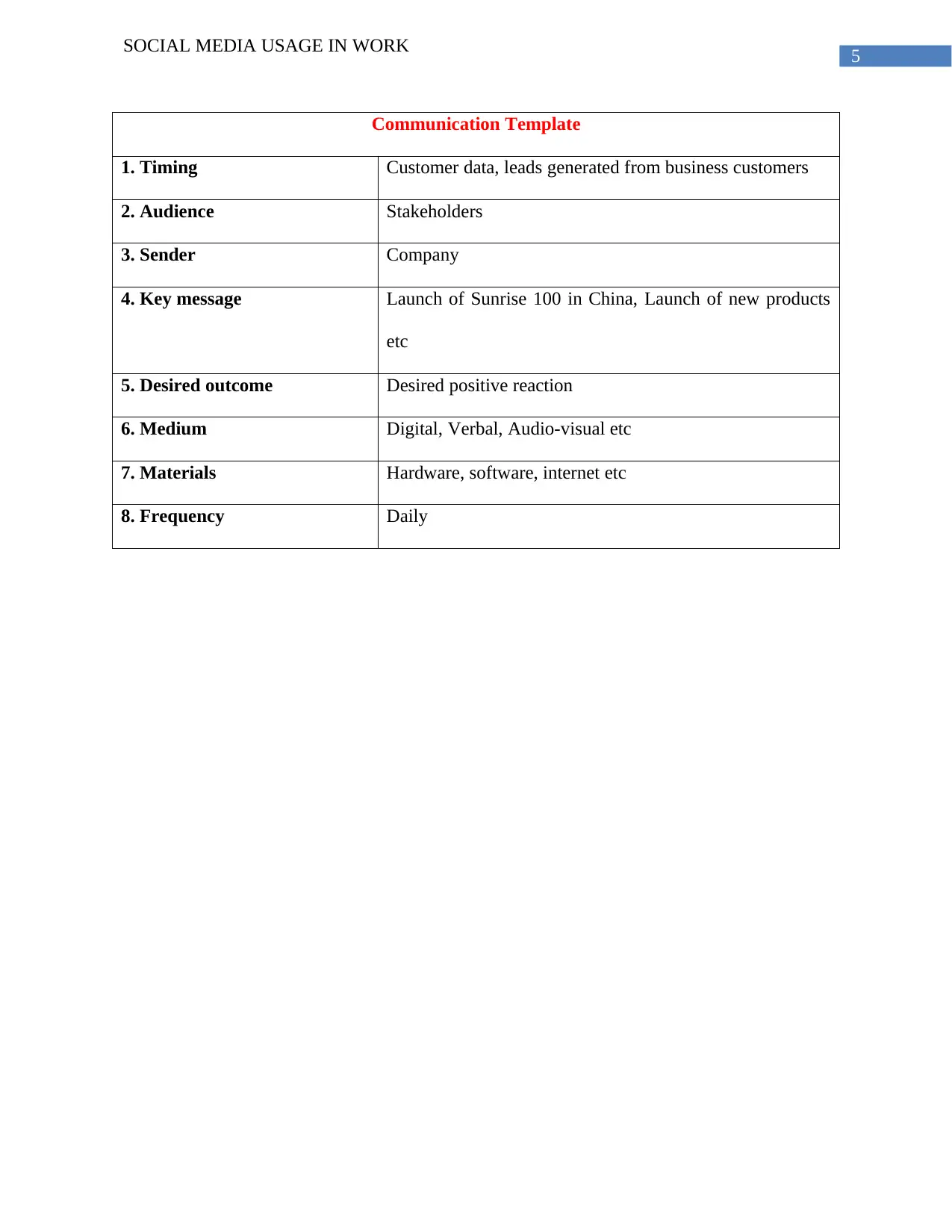
5
SOCIAL MEDIA USAGE IN WORK
Communication Template
1. Timing Customer data, leads generated from business customers
2. Audience Stakeholders
3. Sender Company
4. Key message Launch of Sunrise 100 in China, Launch of new products
etc
5. Desired outcome Desired positive reaction
6. Medium Digital, Verbal, Audio-visual etc
7. Materials Hardware, software, internet etc
8. Frequency Daily
SOCIAL MEDIA USAGE IN WORK
Communication Template
1. Timing Customer data, leads generated from business customers
2. Audience Stakeholders
3. Sender Company
4. Key message Launch of Sunrise 100 in China, Launch of new products
etc
5. Desired outcome Desired positive reaction
6. Medium Digital, Verbal, Audio-visual etc
7. Materials Hardware, software, internet etc
8. Frequency Daily
⊘ This is a preview!⊘
Do you want full access?
Subscribe today to unlock all pages.

Trusted by 1+ million students worldwide
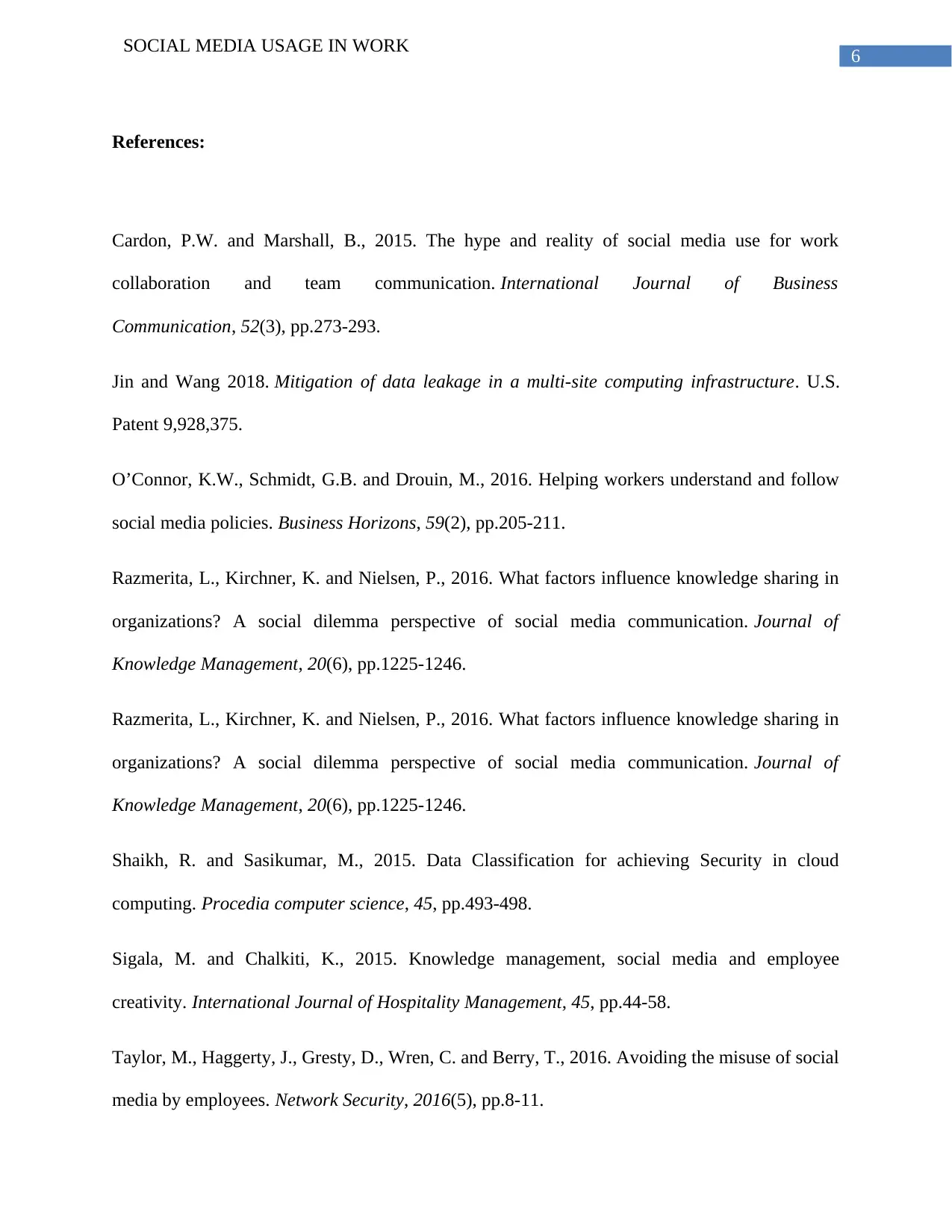
6
SOCIAL MEDIA USAGE IN WORK
References:
Cardon, P.W. and Marshall, B., 2015. The hype and reality of social media use for work
collaboration and team communication. International Journal of Business
Communication, 52(3), pp.273-293.
Jin and Wang 2018. Mitigation of data leakage in a multi-site computing infrastructure. U.S.
Patent 9,928,375.
O’Connor, K.W., Schmidt, G.B. and Drouin, M., 2016. Helping workers understand and follow
social media policies. Business Horizons, 59(2), pp.205-211.
Razmerita, L., Kirchner, K. and Nielsen, P., 2016. What factors influence knowledge sharing in
organizations? A social dilemma perspective of social media communication. Journal of
Knowledge Management, 20(6), pp.1225-1246.
Razmerita, L., Kirchner, K. and Nielsen, P., 2016. What factors influence knowledge sharing in
organizations? A social dilemma perspective of social media communication. Journal of
Knowledge Management, 20(6), pp.1225-1246.
Shaikh, R. and Sasikumar, M., 2015. Data Classification for achieving Security in cloud
computing. Procedia computer science, 45, pp.493-498.
Sigala, M. and Chalkiti, K., 2015. Knowledge management, social media and employee
creativity. International Journal of Hospitality Management, 45, pp.44-58.
Taylor, M., Haggerty, J., Gresty, D., Wren, C. and Berry, T., 2016. Avoiding the misuse of social
media by employees. Network Security, 2016(5), pp.8-11.
SOCIAL MEDIA USAGE IN WORK
References:
Cardon, P.W. and Marshall, B., 2015. The hype and reality of social media use for work
collaboration and team communication. International Journal of Business
Communication, 52(3), pp.273-293.
Jin and Wang 2018. Mitigation of data leakage in a multi-site computing infrastructure. U.S.
Patent 9,928,375.
O’Connor, K.W., Schmidt, G.B. and Drouin, M., 2016. Helping workers understand and follow
social media policies. Business Horizons, 59(2), pp.205-211.
Razmerita, L., Kirchner, K. and Nielsen, P., 2016. What factors influence knowledge sharing in
organizations? A social dilemma perspective of social media communication. Journal of
Knowledge Management, 20(6), pp.1225-1246.
Razmerita, L., Kirchner, K. and Nielsen, P., 2016. What factors influence knowledge sharing in
organizations? A social dilemma perspective of social media communication. Journal of
Knowledge Management, 20(6), pp.1225-1246.
Shaikh, R. and Sasikumar, M., 2015. Data Classification for achieving Security in cloud
computing. Procedia computer science, 45, pp.493-498.
Sigala, M. and Chalkiti, K., 2015. Knowledge management, social media and employee
creativity. International Journal of Hospitality Management, 45, pp.44-58.
Taylor, M., Haggerty, J., Gresty, D., Wren, C. and Berry, T., 2016. Avoiding the misuse of social
media by employees. Network Security, 2016(5), pp.8-11.
Paraphrase This Document
Need a fresh take? Get an instant paraphrase of this document with our AI Paraphraser
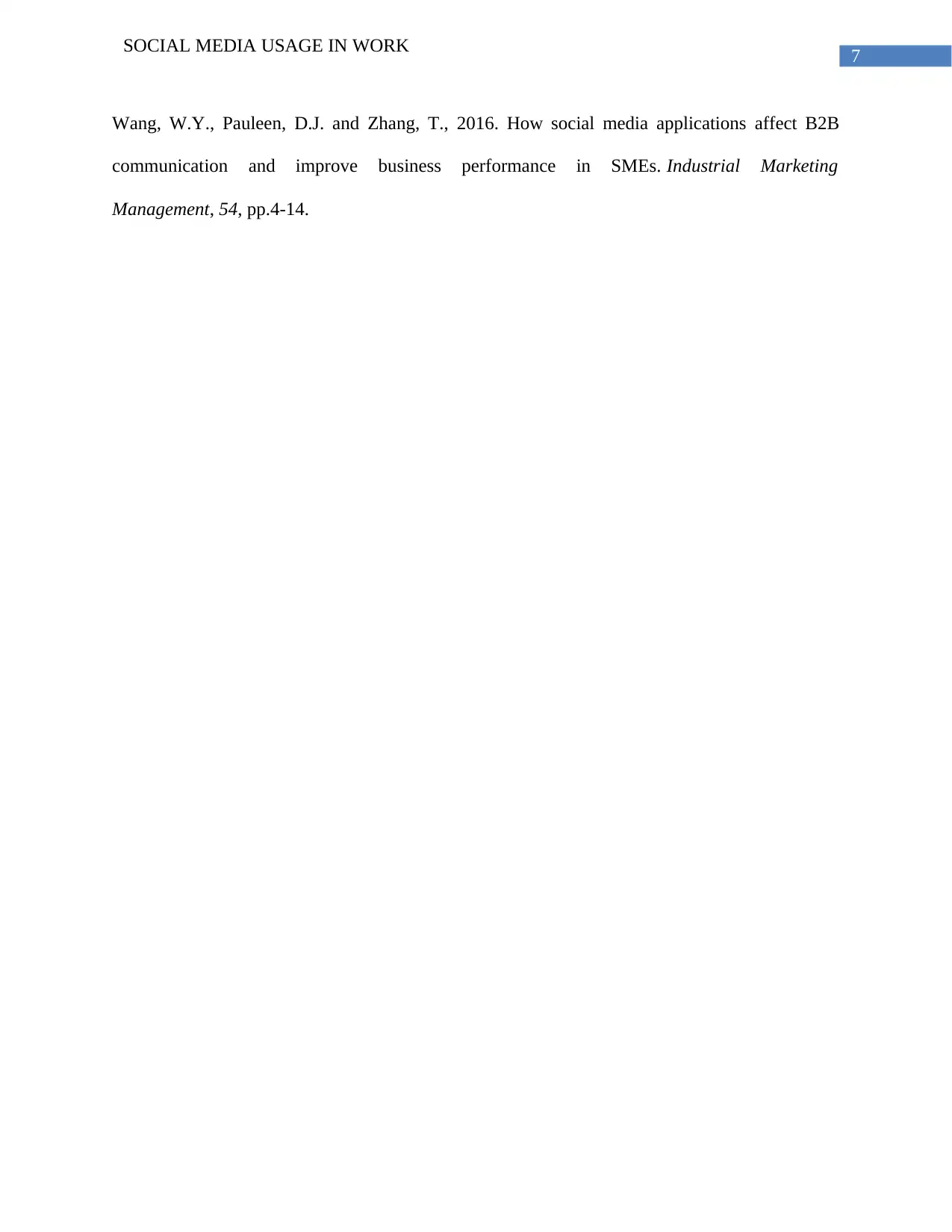
7
SOCIAL MEDIA USAGE IN WORK
Wang, W.Y., Pauleen, D.J. and Zhang, T., 2016. How social media applications affect B2B
communication and improve business performance in SMEs. Industrial Marketing
Management, 54, pp.4-14.
SOCIAL MEDIA USAGE IN WORK
Wang, W.Y., Pauleen, D.J. and Zhang, T., 2016. How social media applications affect B2B
communication and improve business performance in SMEs. Industrial Marketing
Management, 54, pp.4-14.
1 out of 8
Related Documents
Your All-in-One AI-Powered Toolkit for Academic Success.
+13062052269
info@desklib.com
Available 24*7 on WhatsApp / Email
![[object Object]](/_next/static/media/star-bottom.7253800d.svg)
Unlock your academic potential
Copyright © 2020–2025 A2Z Services. All Rights Reserved. Developed and managed by ZUCOL.


